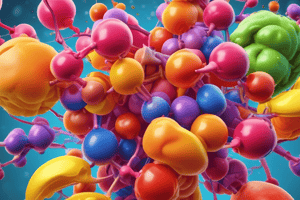Podcast
Questions and Answers
What is the primary process that allows macromolecules to disassemble into monomers?
What is the primary process that allows macromolecules to disassemble into monomers?
- Dehydration reaction
- Oxidation reaction
- Hydrolysis reaction (correct)
- Condensation reaction
Which macromolecule is composed primarily of nucleotide monomers?
Which macromolecule is composed primarily of nucleotide monomers?
- Nucleic acids (correct)
- Proteins
- Carbohydrates
- Lipids
Which statement best describes the role of dehydration reactions in biological systems?
Which statement best describes the role of dehydration reactions in biological systems?
- They form covalent bonds between monomers. (correct)
- They catalyze the activity of enzymes.
- They break down polymers into monomers.
- They create hydrogen bonds in macaromolecules.
What distinguishes starch from cellulose in their biological function?
What distinguishes starch from cellulose in their biological function?
How do the specific types of monomers in a polymer influence its properties?
How do the specific types of monomers in a polymer influence its properties?
Which type of carbohydrate is primarily involved in energy storage?
Which type of carbohydrate is primarily involved in energy storage?
What structural feature differentiates beta-linkages in cellulose from alpha-linkages in starch?
What structural feature differentiates beta-linkages in cellulose from alpha-linkages in starch?
What role do monomers play in the creation of diverse macromolecules?
What role do monomers play in the creation of diverse macromolecules?
What is a primary function of carbohydrates in the human body?
What is a primary function of carbohydrates in the human body?
Which structural feature distinguishes lipids from true polymers?
Which structural feature distinguishes lipids from true polymers?
How do variations in carbohydrate structures influence their biological functions?
How do variations in carbohydrate structures influence their biological functions?
What is the significance of complementary base pairing in nucleic acids?
What is the significance of complementary base pairing in nucleic acids?
Why is protein folding critical for biological function?
Why is protein folding critical for biological function?
What key role do lipids play in cellular membranes?
What key role do lipids play in cellular membranes?
Which characteristic of proteins directly influences their function?
Which characteristic of proteins directly influences their function?
What is a crucial aspect of carbohydrates that influences their diversity?
What is a crucial aspect of carbohydrates that influences their diversity?
What role does proteomics play in biological inquiry?
What role does proteomics play in biological inquiry?
What signifies the diverse functions of lipids in biological systems?
What signifies the diverse functions of lipids in biological systems?
Which function does nucleic acid diversity support in biological systems?
Which function does nucleic acid diversity support in biological systems?
What primarily distinguishes carbohydrates from other macromolecules?
What primarily distinguishes carbohydrates from other macromolecules?
How do technological advances in genomics impact biological research?
How do technological advances in genomics impact biological research?
What mechanism ensures the accuracy of protein synthesis in cells?
What mechanism ensures the accuracy of protein synthesis in cells?
What is the primary type of reaction involved in the formation of covalent bonds between monomers in macromolecules?
What is the primary type of reaction involved in the formation of covalent bonds between monomers in macromolecules?
Which of the following best describes the monomer composition of proteins?
Which of the following best describes the monomer composition of proteins?
Which of the following statements about hydrolysis reactions is accurate?
Which of the following statements about hydrolysis reactions is accurate?
How do starch and cellulose primarily differ in terms of their structural characteristics?
How do starch and cellulose primarily differ in terms of their structural characteristics?
What is the significance of monomer diversity in the construction of biological macromolecules?
What is the significance of monomer diversity in the construction of biological macromolecules?
What role do carbohydrates play in biological systems beyond energy storage?
What role do carbohydrates play in biological systems beyond energy storage?
Which characteristic of carbohydrates is essential for their diverse biological functions?
Which characteristic of carbohydrates is essential for their diverse biological functions?
Which macromolecule is most directly involved in encoding genetic information?
Which macromolecule is most directly involved in encoding genetic information?
Which structural feature distinguishes polysaccharides from proteins or nucleic acids?
Which structural feature distinguishes polysaccharides from proteins or nucleic acids?
Which type of linkage is primarily responsible for the structural integrity of cellulose?
Which type of linkage is primarily responsible for the structural integrity of cellulose?
Which of the following best describes a key role of carbohydrates in the human body?
Which of the following best describes a key role of carbohydrates in the human body?
What is the significance of the diversity in carbohydrate structures?
What is the significance of the diversity in carbohydrate structures?
How do lipids contribute to cellular function?
How do lipids contribute to cellular function?
Which characteristic is crucial in distinguishing lipids from other macromolecules?
Which characteristic is crucial in distinguishing lipids from other macromolecules?
In what way does the structure of proteins influence their function?
In what way does the structure of proteins influence their function?
What is the primary reason misfolded proteins can lead to diseases?
What is the primary reason misfolded proteins can lead to diseases?
What role do nucleic acids play in biological systems?
What role do nucleic acids play in biological systems?
What underlies the concept of complementary base pairing in nucleic acids?
What underlies the concept of complementary base pairing in nucleic acids?
How has the advancement of genomics impacted understanding of biological processes?
How has the advancement of genomics impacted understanding of biological processes?
Flashcards
Macromolecule Polymer
Macromolecule Polymer
A large molecule composed of repeating subunits (monomers) linked together.
Dehydration Reaction
Dehydration Reaction
A chemical reaction where monomers are joined, and a water molecule is produced.
Hydrolysis Reaction
Hydrolysis Reaction
A chemical reaction where polymers break down into monomers, and a water molecule is used.
Carbohydrate Monomer
Carbohydrate Monomer
Signup and view all the flashcards
Starch
Starch
Signup and view all the flashcards
Cellulose
Cellulose
Signup and view all the flashcards
Monomer
Monomer
Signup and view all the flashcards
Protein Monomer
Protein Monomer
Signup and view all the flashcards
Carbohydrate's Function
Carbohydrate's Function
Signup and view all the flashcards
Lipid Structure
Lipid Structure
Signup and view all the flashcards
Lipid Function
Lipid Function
Signup and view all the flashcards
Protein Structure
Protein Structure
Signup and view all the flashcards
Protein Diversity
Protein Diversity
Signup and view all the flashcards
Protein Function
Protein Function
Signup and view all the flashcards
Protein Folding
Protein Folding
Signup and view all the flashcards
Nucleic Acid's Structure
Nucleic Acid's Structure
Signup and view all the flashcards
Base Pairing
Base Pairing
Signup and view all the flashcards
Nucleic Acid roles
Nucleic Acid roles
Signup and view all the flashcards
Genomics
Genomics
Signup and view all the flashcards
Proteomics
Proteomics
Signup and view all the flashcards
Carbohydrate Diversity
Carbohydrate Diversity
Signup and view all the flashcards
Lipid Diversity
Lipid Diversity
Signup and view all the flashcards
Starch vs. Cellulose
Starch vs. Cellulose
Signup and view all the flashcards
Why can't we digest cellulose?
Why can't we digest cellulose?
Signup and view all the flashcards
How do monomers create diversity?
How do monomers create diversity?
Signup and view all the flashcards
Importance of dehydration and hydrolysis
Importance of dehydration and hydrolysis
Signup and view all the flashcards
What makes carbohydrates unique?
What makes carbohydrates unique?
Signup and view all the flashcards
Lipid Properties
Lipid Properties
Signup and view all the flashcards
Lipid Function in Membranes
Lipid Function in Membranes
Signup and view all the flashcards
Protein Folding Importance
Protein Folding Importance
Signup and view all the flashcards
Complementary Base Pairing
Complementary Base Pairing
Signup and view all the flashcards
Study Notes
Macromolecules: An Overview
- Macromolecules (carbohydrates, proteins, nucleic acids) are polymers built from monomers.
- Polymers are formed via dehydration reactions (removing water) where covalent bonds are formed between monomers.
- Polymers break down into monomers via hydrolysis (adding water).
- A small set of monomers creates a vast array of polymers, showcasing biological diversity.
- Monomers are the building blocks for complex macromolecules; their specific sequence defines polymer properties and functions.
- The fundamental differences between large carbohydrates, proteins, and nucleic acids lie in their monomer types and the bonds holding them together.
- Carbohydrates are composed of sugar monomers, proteins of amino acids, and nucleic acids of nucleotides.
- Monomers serve as the building blocks for complex structures, enabling the formation of diverse macromolecules.
- The specific sequence and type of monomers determine the properties and functions of the resulting polymer allowing organisms to efficiently create complex molecules necessary for life.
- Dehydration reactions are crucial for macromolecule synthesis and formation of covalent bonds.
- Hydrolysis reactions are equally important for the breakdown of polymers into usable monomers, fundamental to metabolism.
Carbohydrates: Fuel and Structure
- Carbohydrates are crucial for energy storage and structural support.
- They exist as monosaccharides, disaccharides, and polysaccharides.
- Starch (energy storage in plants, digestible), and cellulose (plant cell wall support, indigestible by humans) are both polysaccharides but differ structurally. Cellulose has beta linkages.
- Carbohydrates are a primary energy source in humans, impacting cellular processes and metabolic functions.
- Carbohydrate diversity allows various functions in biological systems.
- Carbohydrates are involved in cell recognition and signaling, affecting immune responses and cellular communication.
- Dietary carbohydrates are crucial for maintaining energy levels and supporting metabolic functions.
- The diversity of carbohydrate structures allows for a wide range of functions in biological systems through variations in monomer types, linkages, and branching patterns.
Lipids: Hydrophobic Molecules
- Lipids are a diverse group of hydrophobic molecules (fats, oils, phospholipids, steroids).
- Lipids aren't polymers; they consist of smaller units like fatty acids and glycerol, formed through ester linkages.
- Lipids are hydrophobic, crucial for cell membranes and energy storage.
- Lipids lack repeating monomer units, thus not considered polymers.
- Lipids play vital roles in energy storage, membrane structure, and signaling molecules.
- The diversity of lipid structures allows for a wide range of functions in biological systems, through variations in fatty acid chain length, saturation, and functional groups.
Proteins: Diverse Structures and Functions
- Proteins are amino acid polymers linked by peptide bonds, forming complex three-dimensional structures.
- Protein structure (primary, secondary, tertiary, quaternary) dictates function.
- Protein diversity arises from numerous amino acid sequences and combinations.
- Proteins are essential for virtually all biological processes – catalysis, transport, structural support, immune responses, signaling, and gene expression regulation.
- Proper protein folding is crucial for function; incorrect folding can cause diseases.
- The sequence of amino acids determines a protein's structure and function, with four levels of organization.
Nucleic Acids: Hereditary Information
- Nucleic acids (DNA and RNA) are nucleotide polymers.
- They store, transmit, and express hereditary information.
- Nucleotide sequences encode genetic information, crucial for protein synthesis.
- Complementary base pairing (A-T, C-G) is fundamental to nucleic acid structure and function.
- Nucleic acids are essential for hereditary information transfer and cellular processes.
- The diversity of nucleic acid structures allows for a wide range of functions in biological systems, through variations in nucleotide sequences and modifications.
Genomics and Proteomics in Research
- DNA sequencing advancements allow analysis of whole genomes and gene sets.
- Genomics studies these large data sets to explore genetic variation, evolution, and disease.
- Proteomics studies large protein sets, complementing genomics.
- Bioinformatics uses computational tools to analyze genomic and proteomic data, revealing patterns and relationships within complex biological data, aiding medical and biotech research.
- Genomic data shows evolutionary relationships between species, confirming models based on fossils and anatomy; the more closely related two species are, the more similar their DNA sequences.
Studying That Suits You
Use AI to generate personalized quizzes and flashcards to suit your learning preferences.




